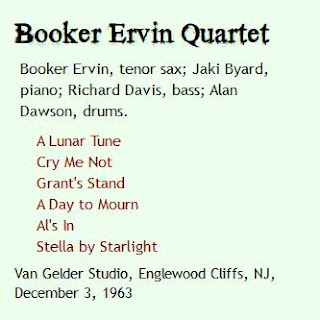LISTEN TO ONE: Wives and Lovers
Red Holloway, Jack McDuff, Joe Dukes and George Benson found themselves in Los Angeles--they were one of the most popular touring jazz groups in the country at this point, and they could have been found almost anywhere on any given date. But they were in LA, along with Lew Futterman, McDuff's manager and producer, and with no shortage of recording studios in the city of angels, Futterman brought them in for two days of recording in various formats, and under various names.
LISTEN TO ONE: What's New
First came a session that would be released under Holloway's name, as it was largely a showcase for his gifts as a composer. It was the basic quartet, plus West Coast bassist Wilfred Middlebrooks, and it began with two ballads before moving on to Holloway's various variations on jazz funk.
"This Can't Be Love" was a familiar Rodgers and Hart standard from the 1930s. A ballad taken at a brisk tempo, it featured McDuff moving over to piano for the first time on record.
 |
"Wives and Lovers," a recent hit by Burt Bacharach and Hal David, was on its way to becoming as popular as any ballad from the Great American Songbook. A 1963 release that would win crooner Jack Jones a 1964 Grammy, it would go on to become a favorite of lounge singers, and a wide assortment of instrumental aggregations, from Lawrence Welk and Jerry Murad's Harmonicats to Stan Getz and Thad Jones / Pepper Adams. It was a song in a sort of new genre, the "exploitation song." Wives and Lovers was a movie with Janet Leigh and Van Johnson, and Bacharach had been engaged to write a song, but not for the movie's soundtrack. The producers wanted--and got--a top 40 hit that would get the movie's title out there, and draw attention to it. Bacharach had done this once before, for movie that seemed an even more unlikely inspiration for a hit song, The Man Who Shot Liberty Valance.
Holloway demonstrated some nice versatility as a composer, keeping the blues a thematic base. His compositions took front and center for Prestige's two 45 RPM single releases from the album, "Denise / Wives and Lovers" and "No Tears" / "Shout Brother." Billing was "Red Holloway with the Jack McDuff Quartet," and the album was entitled Cookin' Together.
LISTEN TO ONE: Redwood City
The Holloway session is listed as having taken place on February 6 (a Thursday), the other two on February 6-7. Which seems odd. For the middle session, the quartet, they drop the bass player and go back to their regular quartet lineup. For the final session, a bass player returns, but a different one, and they add another horn. It seems unlikely that they would have done a little with the quartet and a little with the sextet on Thursday (after having done a seven-tune set with the quintet) then called it a day, then a little more with both lineups on Friday. In any event, all this music was made in two days. The last lineup, the sextet, recorded as the Nomos, which may well have meant "No mo' of this jive, we're getting back on the road."
The quartet sounds good, as always, with each member getting ample solo space, and young George Benson sounding better and better. The material is a standard, Bob Haggart and Johnny Burke's "What's New?" and two originals by McDuff.
It seems each soloist gets a session as composer. The Nomos do two tunes by Benson, "Redwood City," a long and a short version, and "Step Out and Get It." A third, "Long Distance," presumably also by the guitarist, was canned. The quartet is augmented by a bassist, Tommy Shelvin, and New Orleans native Alvin "Red"Tyler on baritone sax. Tyler was a veteran of Cosimo Matassa's studio in New Orleans, and had played on recordings by Little Richard and Fats Domino, and he adds a richness to the sound. Benson would record "Redwood City" again with his own group.
The quartet sessions would be added to a second session with Benny Golson and a full orchestra. "Rail Head" would be on a 45 RPM single, with one of the tunes from the Golson session on the flip side. The Nomos didn't get an album. The long version of "Redwood City" would be included on a 1970 release, Gene Ammons/Richard "Groove" Holmes/Eddie "Lockjaw" Davis With Shirley Scott/Willis Jackson/The Nomos/Brother Jack McDuff - The Soul/Jazz Giants (Previously Unissued Material). The short version, and "Step Out and Get It," became a 45 RPM single. Futterman handled the production for both days and all lineups.



:format(jpeg):mode_rgb():quality(90)/discogs-images/R-14108395-1568038245-6248.jpeg.jpg)













:format(jpeg):mode_rgb():quality(90)/discogs-images/R-12554352-1537521871-8684.jpeg.jpg)

